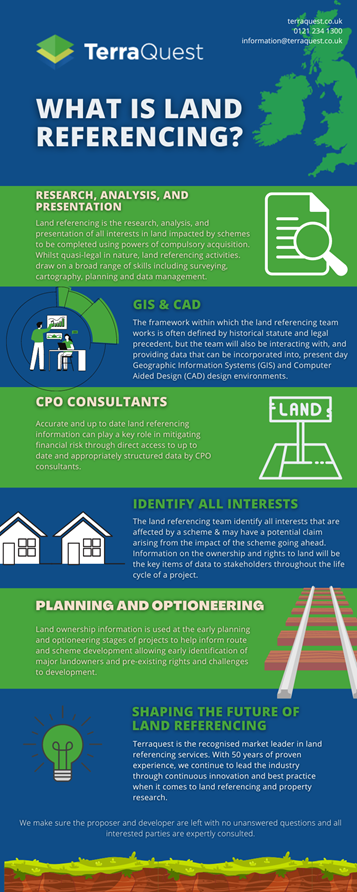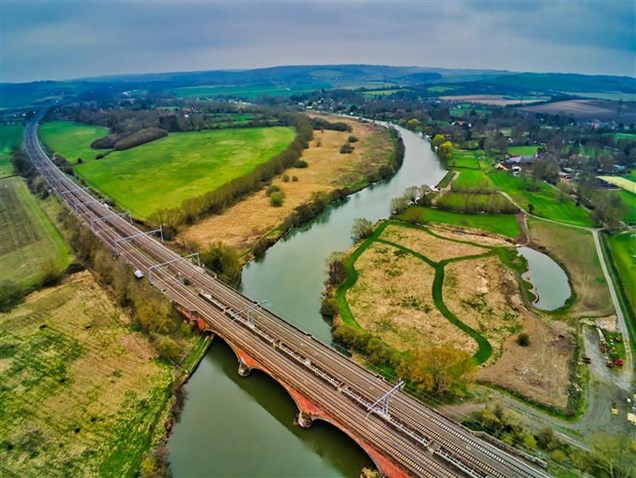
TerraQuest News
- Jul 2022
Part 1: What is Land Referencing and why is it so crucial to infrastructure projects?
1. Land referencing – What?
Land referencing is the research, analysis, and presentation of all interests in land impacted by schemes to be completed using powers of compulsory acquisition. Whilst quasi-legal in nature, land referencing activities draw on a broad range of skills including surveying, cartography, planning and data management. The framework within which the land referencing team works is often defined by historical statute and legal precedent, but the team will also be interacting with, and providing data that can be incorporated into, present day Geographic Information Systems (GIS) and Computer Aided Design (CAD) design environments to facilitate dissemination of information to key stakeholders across a project.
A recognised challenge to major infrastructure projects is that of compulsory purchase management and the need to bring more certainty and control to scheme budget and risk management. Accurate and up to date land referencing information can play a key role in mitigating financial risk through direct access to up to date and appropriately structured data by CPO consultants.

2. Land referencing – Why?
The land referencing team’s principal role is to identify all interests that are affected by a scheme and may have a potential claim arising from the impact of the scheme going ahead. Information on the ownership and rights to land will be the key items of data to stakeholders throughout the life cycle of a project.
2.1 Planning and Optioneering
Land ownership information is used at the early planning and optioneering stages of projects to help inform route and scheme development allowing early identification of major landowners and pre-existing rights and challenges to development. Access to reliable land ownership information at these early stages allows the project stakeholders to manage the risks associated with acquisition of rights in land, including those arising from planning actions such as Safeguarding Directions and the creation of Statutory Blight often associated with major infrastructure projects.
2.2 Early Access
As the preliminary scheme designs emerge, project stakeholders will be looking to engage with landowners to arrange early access to land for investigation and survey work. The land referencing team are well placed to identify the owners to be contacted and to provide an interface with all parties to facilitate agreement. Such an interface may consist solely of the distribution of documentation supporting the request but could also require the referencing team to make the initial contact with landowners and to provide sufficient engagement, negotiation, and payment services deemed necessary to secure access.
2.3 Schedules and Plans
Building on the information collated at these early design and engagement stages, the referencing team will soon be tasked with the preparation of documentation that will form a key part of the application or submission put forward in support of the schemes approval. Whilst schemes may choose one of a small number of statutory instruments; a hybrid Bill, a Development Consent Order, a Transport and Works Act Order, a Compulsory Purchase Order and a Highways Order are typical, for all the requirement is to provide a comprehensive report with plans and other associated documentation on the interests in land that are impacted by the proposed scheme. The legislation supporting the different instruments may specify a variety of layouts, content and presentation of such reports and plans, but the fundamental expectation with all is:
- the data presented has been researched with diligence.
- the data is as up to date as possible
- the data is as complete as possible
- the data is presented in a way that meets the requirements of the legislation under which powers of acquisition are being sought

2.4 Communication and Consultation
As well as contributing to documents presented as part of any application or bill deposit, the referencing team will also provide research and production support to project stakeholders with respect to the communication of information to affected parties and members of the general public at prescribed milestones along the project programme. The completion of any such communication exercise will rely on the contact information collated by the referencing team as part of earlier research activities.
Communication activities will be varied, ranging from the publication of general project consultation information and invitations to affected parties to make contact with the project and initiate dialogue. It also includes the prescribed service of notices advising affected parties that key stages of the project have been reached and what comes next.
2.5 Application Support
Once an application or bill has been submitted the role of the land referencing team changes to one of support and maintenance during what is essentially a review stage. The role of the Planning Inspectorate, Parliamentary Committee or a Public Inquiry is to test the efficacy of a submitted application and the data on which it is built.
2.6 Land Acquisition
The aim of any application is to secure powers to acquire interests in land on behalf of the Acquiring Authority. Once these powers have been obtained, the Acquiring Authority will look to exercise these powers in a timely manner in accordance with the legislation under which they have been granted. The powers to acquire land compulsorily will be time limited and the Acquiring Authority will wish to ensure that all required interests have been acquired prior to the expiry of its powers to do so. Once powers have been obtained the land referencing team, working alongside the Acquiring Authority legal team, will commence notification of interested parties to inform them of the result of the review stage and how the formal acquisition of land interests will proceed.
2.7 Estate Management
As acquisition of land progresses, the Acquiring Authority becomes a landowner and will be expected to manage this land in a responsible manner.
The new owner will be required to apply to register the change of ownership with the Land Registry, with the success of such an application relying on the accuracy and completeness of records presented along with the application. The content of the application will need to demonstrate that all interests in land have been identified and have been acquired in accordance with the legal requirements pertaining to each acquisition method including notification, service of notices and certification of tasks completed. It will be the land referencing teams responsibility to supply much of the evidence required to support this process.
Watch out for part 2, our next blog, where we discuss when should Land Referencing be carried out.
Find out about our Land Referencing services.


